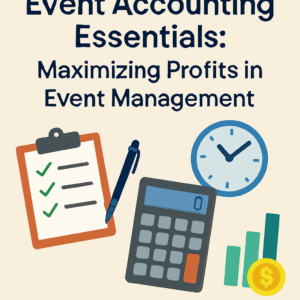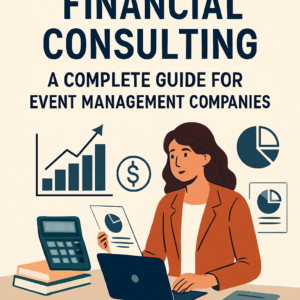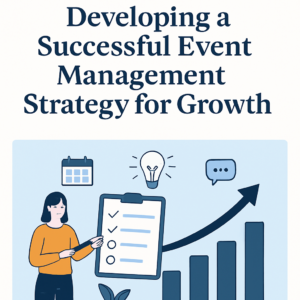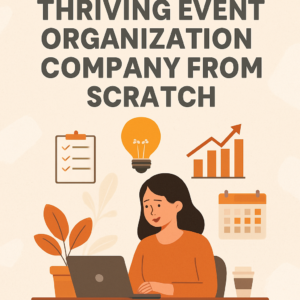The Ultimate Guide to Maximizing Profits in Corporate Event Planning
If you’re in the corporate event management business, you know that maximizing profits is more than just a numbers game—it’s an art form! After all, who doesn’t enjoy the sweet smell of a bottom line that just keeps growing? But let’s be real for a second; profit maximization isn’t a magic trick. It requires a strategic blend of creativity and smart financial planning. From cost reduction strategies to revenue enhancement methods, there’s a lot to unpack.
Whether you’re planning a lavish gala or an intimate corporate retreat, understanding how to optimize your financial performance can feel like trying to find your way through a maze with no exit signs. Don’t sweat it! We’re here to break it down into actionable tips that not only make sense but can also boost your income and improve your bottom line.
In this guide, we’ll help you unlock the secrets of profit optimization while throwing in some lighthearted banter (because who says finance has to be boring?). Ready to turn those events into profit machines? Let’s dive in!
Understanding Profit Maximization in Event Planning
When it comes to corporate event planning, the term “profit maximization” might sound like one of those finance jargon phrases that make your head spin. But fear not! Let’s break it down into something digestible—like a tasty canapé at a networking event.
What is Profit Maximization?
In simple terms, profit maximization is all about maximizing your earnings from each event you organize. It’s not just about raking in the dough; it’s about ensuring that each aspect of your event contributes positively to your bottom line. Think of it as a well-orchestrated symphony—each instrument (or financial strategy) has a role in creating a harmonious tune of revenue growth!
Why is Understanding Profit Maximization Crucial?
Picture this: You’ve just pulled off an incredible event, everyone’s dancing and having a blast, but when the dust settles, you find out you barely broke even. Ouch! Understanding profit maximization helps you avoid these costly surprises. Here are a few reasons why:
- Sustainable Growth: Knowing how to enhance your profits helps ensure that your business remains viable in the long run.
- Better Decision-Making: With clear financial insights, you can make decisions that truly benefit your company—no more guesswork!
- Competitive Edge: When you understand the ins and outs of profit optimization, you’ll gain an edge over competitors who haven’t quite figured it out yet.
Strategies for Profit Maximization in Event Planning
If you’re ready to turn those events into cash cows (well, maybe not literal cows), here are some strategies to get started:
- Cost-Benefit Analysis: Before every event, conduct a thorough cost-benefit analysis to see what expenditures will actually lead to higher profits.
- Pricing Strategy: Don’t sell yourself short! Ensure your pricing reflects the true value you’re providing while remaining competitive.
- Sustainable Practices: Implement sustainable practices not just for good karma but also for potential cost savings—think digital invites instead of paper ones!
A little humor goes a long way here: Just remember—if something sounds too good to be true (like flying pigs), it probably won’t help with profit maximization!
The key takeaway? Mastering profit maximization isn’t just about knowing the numbers; it’s about integrating smart strategies into every phase of planning. The more you understand how each aspect contributes to financial performance improvement, the better positioned you’ll be for success.
“Success is where preparation and opportunity meet.” — Bobby Unser
This timeless wisdom rings especially true in corporate event planning. With solid profit-focused strategies and an understanding of business profitability, you’re setting yourself up for not just one successful event but many more to come!
Implementing Strategic Pricing Strategies
When it comes to squeezing every bit of juice out of those profits in corporate event planning, your pricing strategy is like the cherry on top of a well-structured sundae. It’s not just about slapping a number on your services and calling it a day; it’s about strategic thinking, market knowledge, and yes, a little bit of psychology.
Understanding Your Value Proposition
First things first—what exactly are you offering? Your value proposition is crucial in determining how you price your events. Are you providing high-end luxury experiences or budget-friendly options? Knowing where you stand helps align your pricing with client expectations.
- Identify Unique Selling Points: Are you known for breathtaking venues or stellar catering? Highlight these aspects to justify premium prices.
- User Experience Matters: A seamless booking process and attentive service can warrant higher fees. If your clients feel cherished, they’re often willing to pay more!
The Art of Competitive Analysis
Imagine trying to make a soufflé without knowing how high your neighbors’ ovens are set. The same goes for pricing! Conducting competitive analysis allows you to gauge where you fit into the market landscape.
- Benchmark Against Peers: Keep an eye on what competitors are charging for similar services—this gives you a framework while also highlighting opportunities for differentiation.
- Simplify Comparisons: Create packages that are easy for potential clients to compare with others in the market. This transparency builds trust!
Tiers and Packages: The Pricing Ladder
A well-crafted tiered pricing structure can simplify decision-making for clients while maximizing profits. Think of it as giving them options without overwhelming their taste buds.
- Your Basic Package: Offer essential services at an entry-level price point that allows clients to test the waters.
- The Mid-Tier Delight: Add in some extra features here—perhaps additional décor or upgraded AV equipment—to entice those who want a bit more without going overboard.
- The Luxe Experience: Finally, don’t be shy about showcasing your most extravagant offerings! This is where those high-profit margins come into play.
Dynamism in Pricing: Flexibility is Key
The event industry can be unpredictable, and sometimes, flexibility is essential. Consider dynamic pricing based on demand, seasonality, or even client loyalty and past engagements.
- Packing Events with Discounts: Offering early bird rates or group discounts can boost bookings while keeping profits intact when managed correctly!
- Loyalty Programs: Reward returning clients with special rates—this not only fosters long-term relationships but encourages repeat business!
“In this world nothing can be said to be certain, except death and taxes.” — Benjamin Franklin (and sometimes your client’s last-minute changes!)
Implementing strategic pricing strategies doesn’t have to feel like solving a Rubik’s Cube blindfolded. Approach it step-by-step, utilizing careful analysis and an understanding of both client needs and market dynamics. With a solid plan in place, you’ll see not just an uptick in sales but also enhanced customer satisfaction—a win-win!
If you’re ready to take the plunge into profit-driven decision-making through effective pricing, remember that it’s all part of creating memorable experiences that keep clients coming back for more…
Enhancing Revenue Growth with Innovative Sales Tactics
When it comes to enhancing revenue growth, think of your sales tactics as the secret sauce that can elevate a dish from good to gourmet! In the world of corporate event management, innovative sales strategies are essential for attracting clients and ensuring your events don’t just meet expectations but exceed them—while keeping your profit margins healthy.
Personalization is Key
Today’s clients crave experiences tailored just for them. A one-size-fits-all approach? That’s so last decade! Start incorporating personalized touchpoints in your sales process:
- Know Your Client: Research their preferences before the initial meeting. A little extra effort can go a long way—think about how you’d feel if someone remembered your favorite coffee order!
- Customized Proposals: Instead of sending cookie-cutter packages, create customized proposals that reflect their specific needs and goals. This not only shows you care but also justifies premium pricing.
Leverage Technology
If you’re still relying solely on spreadsheets and paper planners, it’s time to join the 21st century! Utilizing technology can streamline your processes and enhance client interactions:
- CRM Systems: Customer Relationship Management tools help track interactions with potential clients, making follow-ups more targeted and effective.
- Email Automation: Use automated email campaigns to nurture leads. Share valuable content like tips on planning successful events or highlight past successes—this keeps you top-of-mind without being pushy!
Create Engaging Content
Your website should be more than just a digital business card; it should serve as a hub of valuable content. Consider these tactics to engage potential clients:
- Blog Posts & Case Studies: Share insights into successful events you’ve managed or offer guides on effective corporate strategy in event planning. This positions you as an industry thought leader!
- Social Media Engagement: Don’t just post event photos; ask questions, host polls, and interact with followers. This creates a community around your brand that people want to be part of.
Cultivate Relationships
The best sales strategies are often about relationships rather than cold calls. Here are some ways to cultivate those connections:
- Networking Events: Attend industry events, conferences, or local meetups. Meeting people face-to-face allows you to build trust and rapport far better than emails ever could.
- Client Follow-Ups: After an event, send personalized thank-you notes or check in with clients about their feedback. This shows you value their input and fosters long-term relationships.
“People don’t buy what you do; they buy why you do it.” — Simon Sinek
This quote is especially relevant in our field! Sharing your passion for creating unforgettable experiences will resonate with clients who share similar values—which makes closing deals much smoother!
The Power of Referrals
Your satisfied customers can be your best marketing tool. Harness the power of referrals by implementing these tactics:
- Loyalty Programs: Reward clients who refer new business with discounts or special offers—this not only boosts revenue but strengthens loyalty.
- A Referral Network: Partner with other businesses (like caterers or photographers) to cross-promote services; this opens up new markets while keeping existing clients engaged.
The bottom line? Innovative sales tactics aren’t merely about making a sale—they’re about creating connections, delivering value, and building lasting relationships that lead to continued revenue growth.
If you’re ready to shake things up in your sales approach, remember: every interaction is an opportunity waiting to happen! So, let those creative juices flow and watch as you transform potential leads into loyal clients who can’t wait for their next event!
Optimizing Operational Efficiency for Higher Profits
When it comes to the world of corporate event planning, operational efficiency isn’t just a buzzword; it’s the lifeblood of your business. Think of it as the oil that keeps the gears turning smoothly. If you’re looking to boost your profits, streamlining operations can be your secret weapon! But how do you achieve this elusive state of zen in your processes? Buckle up; we’re diving in!
Streamline Your Processes
Every minute counts when managing events, so start by taking an honest look at your current processes. Are there areas where things get unnecessarily complicated? Here are some tips to simplify the chaos:
- Standard Operating Procedures: Documenting your procedures ensures everyone is on the same page, reducing confusion and mistakes. Plus, it makes onboarding new team members a breeze!
- Checklists Galore: Create checklists for every stage of event planning. They’re not just for kids on field trips! Checklists help ensure tasks are completed and nothing gets overlooked—saving you time and potential headaches.
Effective Resource Allocation
Resource allocation might sound like a corporate term thrown around in board meetings, but it’s essential for maximizing profit margins. You want every dollar spent to contribute to your bottom line:
- Prioritize High-Impact Activities: Identify which aspects of your events bring the most value—whether it’s top-notch catering or stunning venues—and allocate more resources there.
- Evaluate Vendor Relationships: Sometimes you’ve got to play matchmaker! Regularly assess whether you’re getting the best bang for your buck from vendors. Negotiate terms or consider alternatives that might offer better pricing without sacrificing quality.
Leverage Technology
If you’re still sending smoke signals instead of emails, it’s time to embrace technology! There are plenty of software solutions designed specifically for event management that can save you tons of time and effort:
- Project Management Tools: Platforms like Asana or Trello can help keep track of tasks, deadlines, and responsibilities so nothing slips through the cracks.
- Bespoke Event Management Software: Look into specialized software that includes budgeting features, attendee management, and reporting tools—all designed to streamline operations and enhance economic efficiency!
Continuous Improvement: The Never-Ending Journey
No matter how efficient you think you are, there’s always room for improvement! Adopt a mindset geared toward continuous enhancement:
- Solicit Feedback: Your team will have valuable insights on what works well and what doesn’t. Regularly ask for input after each event—it’s like having a focus group without all those fancy snacks!
- A/B Testing: If possible, run experiments with different approaches—whether that’s pricing strategies or marketing tactics—to see what yields better results. It’s like being a mad scientist but with less lab coat drama!
“Efficiency is doing things right; effectiveness is doing the right things.” — Peter Drucker
This quote really encapsulates what you’re aiming for in operational efficiency—it’s all about aligning actions with goals while also ensuring every movement counts toward higher profits.
If you’re ready to optimize operational efficiency for increased profits, remember: successful event management is about striking that perfect balance between creativity and systematic execution. With some fine-tuning here and there (and maybe a sprinkle of humor along the way), you’ll find yourself well on your way toward maximizing those profit margins.
The road to financial gain maximization may take effort, but implementing these actionable strategies will have clients raving about their experiences while boosting your bottom line!
Conducting Cost-Benefit and Break-Even Analyses
Now, let’s talk about two crucial financial tools that can feel like your event management GPS—cost-benefit analysis and break-even analysis. If you want to navigate the sometimes-treacherous waters of profit maximization, these analyses are your trusty life jackets!
Cost-Benefit Analysis: Weighing Your Options
A cost-benefit analysis (CBA) is like putting on a pair of financial glasses—it helps you see the big picture without getting lost in the weeds. This method allows you to evaluate the expected costs versus the potential benefits of any decision you’re considering. Here’s how to get started:
- Identify All Costs: Gather every single expense associated with your event—venue rental, catering, entertainment, marketing, and even those cute little napkin rings you swear are essential.
- Estimate Benefits: Now, quantify what each event could return. Think ticket sales, sponsorships, or even future client engagements that arise from networking opportunities.
Once you’ve compiled this data, it’s time for some math magic! Subtract total costs from total benefits to find out if your decision is sound.
“Math is like love; a simple idea but it can get complicated.” — Your Friendly Event Manager
If the benefits outweigh the costs? Congratulations! You’ve just paved the way for a profitable venture. But if they don’t? Well, it might be time to reconsider (or at least swap out those napkin rings for something more budget-friendly!).
Break-Even Analysis: Finding Your Sweet Spot
The break-even analysis is all about understanding when you’ll start making money versus when you’re just treading water. Essentially, it tells you how much revenue needs to be generated before you cover your costs. Think of it as finding that “just right” temperature in a Goldilocks story—too hot and you’re burned; too cold and you’re left shivering!
- Calculate Fixed Costs: These are costs that remain constant regardless of how many guests show up. Venue rental and staff salaries are good examples.
- Determine Variable Costs: These fluctuate based on attendee numbers—catering per person or materials provided for workshops fall into this bucket.
- Set Your Ticket Price: Decide what you’ll charge attendees. This is where knowing your market comes into play!
The formula for break-even point (BEP) looks like this:
- BEP = Fixed Costs ÷ (Price per Ticket – Variable Cost per Ticket)
This nifty calculation will provide insights into how many tickets need to be sold before reaching profitability!
“It’s not about having great ideas; it’s about having a lot of them.” — Scott Belsky
The beauty of conducting both cost-benefit and break-even analyses is that they empower you to make informed decisions rather than relying on gut feelings alone (although sometimes we could all use a little intuition!). With these analyses in hand, you can confidently say “yes” or “no” to opportunities based on solid data.
If there’s one thing we can agree on, it’s that understanding finances shouldn’t put you into a deep sleep like some boring lecture! Embracing these analyses not only enhances your financial performance improvement but also sets the stage for long-term business sustainability.
So grab those calculators and dive deep into your numbers! The next time someone asks whether an event will be worth it financially, you’ll have all the answers—like a math whiz at a trivia night!
Improving Customer Retention for Consistent Profits
Imagine you’ve just pulled off an incredible corporate event, and your clients are thrilled. But as the confetti settles, you realize that without consistent clients returning for more, your profit margins might soon run dry. This is where improving customer retention becomes not just a strategy but a vital lifeline for your business. After all, it’s far easier (and less expensive) to keep existing clients than to chase after new ones!
The Importance of Customer Retention
Why should you care about keeping your clients happy? Here are some compelling reasons:
- Lower Acquisition Costs: It costs five times more to attract a new customer than it does to keep an existing one. So why not save some cash?
- Loyalty = Profit: Repeat customers are often more profitable; they tend to spend more and refer others.
- Feedback Goldmine: Regular clients provide valuable insights that can help improve your services and fine-tune your offerings.
Strategies for Enhancing Customer Retention
Now that we’ve established why retention is crucial, let’s dive into actionable strategies that can keep those clients coming back for more!
Create Memorable Experiences
Your events are likely the highlight of your client’s year, so make sure they remember them! Consider these ideas:
- Attention to Detail: It’s the little things that count! From personalized welcome messages to thoughtful favors, creating memorable experiences ensures they’ll think of you first next time they need an event planner.
- Unique Themes or Concepts: Go beyond the usual corporate fare! Offer innovative themes or unique experiences that make attending worth their while.
Nurture Relationships Through Communication
Your relationship with clients shouldn’t end when the last guest leaves. Keep the lines open!
- Email Check-Ins: A simple “How did everything go?” email after an event can work wonders in showing you care. It opens up a dialogue for feedback too!
- Create Exclusive Content: Share industry insights or tips through newsletters—this positions you as a valuable resource rather than just a vendor.
Loyalty Programs: Because Everyone Loves Rewards
Loyalty programs aren’t just for coffee shops! Consider implementing one tailored specifically for your services:
- Discounts on Future Events: Give returning clients special rates—they’ll appreciate the gesture while you reap the rewards of their loyalty.
- Add-On Services: If they’ve booked multiple events, offer complimentary add-ons like additional decor or upgraded catering options.
Simplify Client Interaction with Technology
If you’re still using paper contracts and endless emails, it’s time to get tech-savvy! Here’s how tech can help streamline interactions:
- User-Friendly Portals: Consider creating an online portal where clients can manage bookings, make payments, and access post-event reports easily—making their lives simpler means they’ll stick around longer!
- Catering to Preferences: Use CRM systems to track client preferences and past events. This way, you’ll be able to offer tailored suggestions when discussing future opportunities!
“Customer service shouldn’t be a department; it should be the entire company.” — Tony Hsieh
This quote reminds us that customer retention isn’t just about one person; it’s a collective effort requiring everyone on your team to focus on delivering exceptional service. Remember: every interaction builds rapport and trust.
The Bottom Line: A Customer-Centric Approach Equals Profits
A solid focus on improving customer retention not only leads to consistent profits but also fosters long-term relationships built on trust and mutual respect. And in this business, word-of-mouth recommendations from satisfied customers are worth their weight in gold!
If you want those profit margins singing in harmony like a well-rehearsed choir, invest time in retaining those precious clients—the returns will be music to your ears!
Leveraging Financial Performance Improvement Techniques
Let’s be honest: talking about financial performance improvement techniques can feel as exhilarating as watching paint dry. But don’t let that put you off! Think of these strategies as your secret weapons to drive profit maximization and boost your business profitability.
Data-Driven Decision Making
The first step in improving your financial performance is to start making decisions based on data rather than hunches. Here’s how you can elevate your game:
- Track Key Metrics: Identify and monitor essential KPIs (Key Performance Indicators) such as revenue per event, client acquisition cost, and repeat client rates. Understanding these numbers will help you make informed profit-driven decisions.
- Use Financial Dashboards: Technology is your friend! Implementing dashboards that visualize your financial data can provide quick insights into your business’s health, making it easier to spot trends and adapt accordingly.
Invest in Your Team
Your team is the backbone of your operation, and investing in their skills can lead to significant financial performance improvement. Here are some tips:
- Training Programs: Offer workshops or online courses that focus on areas such as sales techniques, customer service excellence, or new technological tools. Educated teams work more efficiently, leading to higher profits!
- Cross-Department Collaboration: Encourage collaboration between your event planners and finance teams. When everyone understands the financial implications of their work, it fosters a culture focused on economic efficiency.
Simplifying Expense Management
An often-overlooked aspect of boosting profits is managing expenses effectively. Streamlining how you track spending can lead to significant savings:
- Implement Budgeting Software: Use digital tools designed for budgeting and expense tracking—this helps ensure every dollar is accounted for without drowning in paperwork!
- Regular Reviews: Conduct monthly reviews of all expenditures to identify areas where you might cut costs without sacrificing quality. This proactive approach can lead to immediate financial gains.
Emphasize Value Over Cost
A common pitfall in corporate event management? Falling into the trap of competing solely on price. Instead, shift your focus toward demonstrating value!
- Create Compelling Proposals: Highlight how unique features or added services justify higher pricing—clients are often willing to pay a bit more if they see tangible benefits!
- Sustainability Practices: Incorporating eco-friendly practices not only appeals to modern clients but also positions you as a responsible choice—potentially allowing for premium pricing due to perceived value.
The Power of Client Feedback
Your clients know what they want—so why not ask them? Gathering feedback post-event helps improve future offerings while ensuring you’re aligning with client needs:
- Satisfaction Surveys: Send out quick surveys after each event asking about various aspects from planning through execution. This data will directly inform future strategies aimed at enhancing profitability.
- User Testimonials: Request testimonials from satisfied clients that showcase the value you provide; sharing these stories can help attract new customers while solidifying relationships with existing ones.
“Feedback is the breakfast of champions.” — Ken Blanchard
This quote rings especially true in our industry! Listening to clients helps keep you relevant while also contributing significantly to your bottom line improvement strategies.
The crux of leveraging financial performance improvement lies in implementing these practical techniques into your daily operations. You may realize that even small tweaks can lead to considerable changes over time—so don’t hesitate! Get proactive about enhancing all aspects of your financial strategy today.
If there’s one thing we know for sure: when it comes down to maximizing profits in corporate event planning, knowledge truly is power!
If you’re in the corporate event management business, you know that maximizing profits is more than just a numbers game—it’s an art form! After all, who doesn’t enjoy the sweet smell of a bottom line that just keeps growing? But let’s be real for a second; profit maximization isn’t a magic trick. It requires a strategic blend of creativity and smart financial planning. From cost reduction strategies to revenue enhancement methods, there’s a lot to unpack.
Whether you’re planning a lavish gala or an intimate corporate retreat, understanding how to optimize your financial performance can feel like trying to find your way through a maze with no exit signs. Don’t sweat it! We’re here to break it down into actionable tips that not only make sense but can also boost your income and improve your bottom line.
In this guide, we’ll help you unlock the secrets of profit optimization while throwing in some lighthearted banter (because who says finance has to be boring?). Ready to turn those events into profit machines? Let’s dive in!









